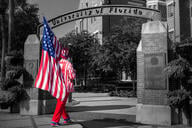You have /5 articles left.
Sign up for a free account or log in.
Why do narratives of decline have such perennial appeal in the liberal arts, especially in the humanities? Why is it, year after year, meeting after meeting, we hear laments about the good old days and predictions of ever worse days to come? Why is such talk especially common in elite institutions where, by many indicators, liberal education is doing quite well, thank you very much. I think I know why. The opportunity is just too ripe for the prophets of doom and gloom to pass up.
There is a certain warmth and comfort in being inside the “last bastion of the liberal arts,” as B.A. Scott characterized prestigious colleges and research universities in his collection of essays The Liberal Arts in a Time of Crisis (NY Praeger, 1990). The weather outside may be frightful, but inside the elite institutions, if not “delightful,” it’s perfectly tolerable, and likely to remain so until retirement time.
Narratives of decline have also been very useful to philanthropy, but in a negative way. As Tyler Cowen recently noted in The New York Times, “many donors … wish to be a part of large and successful organizations -- the ‘winning team’ so to speak.” They are not eager to pour out their funds in order to fill a moat or build a wall protecting some isolated “last bastion.” Narratives of decline provide a powerful reason not to reach for the checkbook. Most of us in the foundation world, like most other people, prefer to back winners than losers. Since there are plenty of potential winners out there, in areas of pressing need, foundation dollars have tended to flow away from higher education in general, and from liberal education in particular.
But at the campus level there’s another reason for the appeal of the narrative of decline, a genuinely insidious one. If something goes wrong the narrative of decline of the liberal arts always provides an excuse. If course enrollments decline, well, it’s just part of the trend. If students don’t like the course, well, the younger generation just doesn’t appreciate such material. If the department loses majors, again, how can it hope to swim upstream when the cultural currents are so strong? Believe in a narrative of decline and you’re home free; you never have to take responsibility, individual or collective, for anything having to do with liberal education.
There’s just one problem. The narrative of decline is about one generation out of date and applies now only in very limited circumstances. It’s true that in 1890, degrees in the liberal arts and sciences accounted for about 75 percent of all bachelor’s degrees awarded; today the number is about 39 percent, as Patricia J. Gumport and John D. Jennings noted in “Toward the Development of Liberal Arts Indicators” (American Academy of Arts and Sciences, 2005). But most of that decline had taken place by 1956, when the liberal arts and sciences had 40 percent of the degrees.
Since then the numbers have gone up and down, rising to 50 percent by 1970, falling to 33 percent by 1990, and then rising close to the 1956 levels by 2001, the last year for which the data have been analyzed. Anecdotal evidence, and some statistics, suggest that the numbers continue to rise, especially in Research I universities.
For example, in the same AAA&S report ("Tracking Changes in the Humanities) from which these figures have been derived, Donald Summer examines the University of Washington (“Prospects for the Humanities as Public Research Universities Privatize their Finances”) and finds that majors in the humanities have been increasing over the last few years and course demand is strong.
The stability of liberal education over the past half century seems to me an amazing story, far more compelling than a narrative of decline, especially when one recognizes the astonishing changes that have taken place over that time: the vast increase in numbers of students enrolled in colleges and universities, major demographic changes, the establishment of new institutions, the proliferation of knowledge, the emergence of important new disciplines, often in the applied sciences and engineering, and, especially in recent years, the financial pressures that have pushed many institutions into offering majors designed to prepare students for entry level jobs in parks and recreation, criminal justice, and now homeland security studies. And, underlying many of these changes, transformations of the American economy.
The Other, Untold Story
How, given all these changes, and many others too, have the traditional disciplines of the arts and sciences done as well as they have? That would be an interesting chapter in the history of American higher education. More pressing, however, is the consideration of one important consequence of narratives of decline of the liberal arts.
This is the “last bastion” mentality, signs of which are constantly in evidence when liberal education is under discussion. If liberal education can survive only within the protective walls of elite institutions, it doesn’t really make sense to worry about other places. Graduate programs, then, will send the message that success means teaching at a well-heeled college or university, without any hint that with some creativity and determination liberal education can flourish in less prestigious places, and that teaching there can be as satisfying as it is demanding.
Here’s one example of what I mean. In 2000, as part of a larger initiative to strengthen undergraduate liberal education, Grand Valley State University, a growing regional public institution in western Michigan, decided to establish a classics department. Through committed teaching, imaginative curriculum design, and with strong support from the administration, the department has grown to six tenured and tenure track positions with about 50 majors on the books at any given moment. Most of these are first-generation college students from blue-collar backgrounds who had no intention of majoring in classics when they arrived at Grand Valley State, but many have an interest in mythology or in ancient history that has filtered down through popular culture and high school curricula. The department taps into this interest through entry-level service courses, which are taught by regular faculty members, not part timers or graduate students.
That’s a very American story, but the story of liberal education is increasingly a global one as well. New colleges and universities in the liberal arts are springing up in many countries, especially those of the former Soviet Union.
I don’t mean that the spread of liberal education comes easily, in the United States or elsewhere. It’s swimming upstream. Cultural values, economic anxieties, and all too often institutional practices (staffing levels, salaries, leave policies and research facilities) all exert their downward pressure. It takes determination and devotion to press ahead. And those who do rarely get the recognition or credit they deserve.
But breaking out of the protective bastion of the elite institutions is vital for the continued flourishing of liberal education. One doesn’t have to read a lot of military history to know what happens to last bastions. They get surrounded; they eventually capitulate, often because those inside the walls squabble among themselves rather than devising an effective breakout strategy. We can see that squabbling at work every time humanists treat with contempt the quantitative methods of their scientific colleagues and when scientists contend that the reason we are producing so few scientists is that too many students are majoring in other fields of the liberal arts.
The last bastion mentality discourages breakout strategies. Even talking to colleagues in business or environmental studies can be seen as collaborating with the enemy rather than as a step toward broadening and enriching the education of students majoring in these fields. The last bastion mentality, like the widespread narratives of decline, injects the insidious language of purity into our thinking about student learning, hinting that any move beyond the cordon sanitaire is somehow foul or polluting and likely to result in the corruption of high academic standards.
All right, what if one takes this professed concern for high standards seriously? What standards, exactly, do we really care about and wish to see maintained? If it’s a high level of student engagement and learning, then let’s say so, and be forthright in the claim that liberal education is reaching that standard, or at least can reach that standard if given half a chance. That entails, of course, backing up the claim with some systematic form of assessment.
That provides one way to break out of the last bastion mentality. One reason that liberal education remains so vital is that when properly presented it contributes so much to personal and cognitive growth. The subject matter of the liberal arts and sciences provides some of the best ways of helping students achieve goals such as analytical thinking, clarity of written and oral expression, problem solving, and alertness to moral complexity, unexpected consequences and cultural difference. These goals command wide assent outside academia, not least among employers concerned about the quality of their work forces. They are, moreover, readily attainable through liberal education provided proper attention is paid to “transference.” “High standards” in liberal education require progress toward these cognitive capacities.
Is it not time, then, for those concerned with the vitality of liberal education to abandon the defensive strategies that derive from the last bastion mentality, and adopt a new and much more forthright stance? Liberal education cares about high standards of student engagement and learning, and it cares about them for all students regardless of their social status or the institution in which they are enrolled.
There is, of course, a corollary. Liberal education can’t just make the claim that it is committed to such standards, still less insist that others demonstrate their effectiveness in reaching them, unless those of us in the various fields of the arts and sciences are willing to put ourselves on the line. In today’s climate we have to be prepared to back up the claim that we are meeting those standards. Ways to make such assessments are now at hand, still incomplete and imperfect, but good enough to provide an opportunity for the liberal arts and sciences to show what they can do.
That story, I am convinced, is far more compelling than any narrative of decline.




